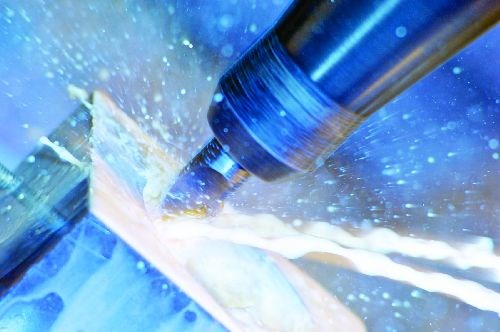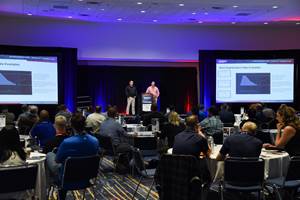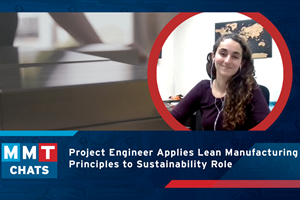People, Products and Possibilities
If you’ve ever thought about not going to a trade show, you might want to think again. I realize there are plenty of events for mold builders so it can be overwhelming—ones focused on plastics or metalworking or a particular end market or region or technology—but the main thing is to get yourself to one to be exposed to the people, products and possibilities out there for new business. Take a look at some direct trade show findings from mold builder Byrne Tool.

If you’ve ever thought about not going to a trade show, you might want to think again. I realize there are plenty of events for mold builders so it can be overwhelming—ones focused on plastics or metalworking or a particular end market or region or technology—but the main thing is to get yourself to one to be exposed to the people, products and possibilities out there for new business. Take a look at some direct trade show findings from mold builder Byrne Tool.
“There are so many different types of software available it makes it difficult to find the best one for your shop. While at the IMTS show in Chicago, we chose to take a look at a few. One particular type we looked at was PowerMill. We focused in on the auto feature recognition aspect of PowerMill and how it would work with different CAD systems.
First, we looked at how the 2D side of the software worked. It has a drilling method feature that allows you to do all of the drilling, tapping and spiral cutting on 2D features. It is set up so that you can tell it to find certain holes by diameter, depth, color and description. It works in a way that can be used with any CAD system, as long as the designers draw the features the same way every time.
For example, a ½ clearance hole is always drawn at .500 with a chamfer. So, you will have to make sure the designs are standardized throughout the entire shop. Once you know what size the hole is, you put a process on it and save it. Then, when the next job comes up with the same feature, PowerMill can auto recognize that feature and run the same process.
Essentially, this 2D method that PowerMill has available allows you to eventually be able to set it up so that you only have to click a couple of buttons and it will do all of the 2D programming for you. This is valuable in many ways. Obviously it saves time, but it also makes sure you are doing the same process on each feature every time. Again, once you figure out the best process, it will do it all the time. If a better process comes along at some point, it’s easy to update your process for that particular item. It also helps eliminate programming errors.
The 3D side of PowerMill can be macro-tized as well. In the 3D side, you can set up templates for each process that you do day in and day out. For example, once you set up the settings for a 2-inch rougher—including speeds, feeds, stepdown, stock allowance, etc.—you can then just save it as a template. That way, when you do the same program again you just call that template out and hit calculate. This not only saves time, but also eliminates errors. This process can be used for every 3D process you do.
You can also go another step further by recording what you are doing in order to tie multiple templates together. For example, if you want to rough with a 2” then a 1” and finally a ½” by recording multiple templates together, you can actually achieve that by clicking one button. There is a lot of prep work that goes into doing this; however, you can immediately see the long-term benefits. I don’t know how many times I’ve seen someone accidently leave zero stock allowance instead of .010 or program for a radius on an insert that was wrong. Using templates and macros certainly helps eliminate these kinds of mistakes.
Additionally, in this trade there is constant training going on and people do things differently. There are always multiple ways of doing things. However, with the 2D PowerMill method using templates and macros, it makes the programming more standardized, just like most designs are standardized. It also makes it easier for someone not as experienced to be able to learn and program some things they may have not been able to.” Steve Willison, CNC Operator/Programmer, Byrne Tool and Die
“This was my first experience at IMTS and I would have to say it was a good one. I’ve only been in the tool and die trade for a couple months as an EDM apprentice for Byrne Tool and Die and after going to this show it gave me confidence in knowing that this is the career I want to pursue.
What astonished me was the size of the show and how many people and companies benefit from the tool and die industry—not only in America, but around the world. I know that this trade was on the decline for the past 10 years or so with companies outsourcing their work to other countries because of lower costs, but now companies are realizing that the type of skills mold building involves doesn’t come cheap. To have a successful mold or die involves skilled and determined workers that America has.
At IMTS I saw a lot of technology that I have never seen before—from 5-axis CNC machines to the latest and greatest wire and sinker EDMs. One aspect of the EDMs that I really liked was the ability to do a workpiece change in the toolchanger. It places the mold in the workpiece holding system on the magnet that is already centered and would reduce any errors in picking up the block. It’s mostly for smaller molds, but would greatly reduce setup times and increase productivity, which I believe would benefit our company in the long run.
The tool and die industry is in dire need of smart people who are willing to learn. Even though this new technology has helped advance the processes of moldmaking it still needs the workers to run these machines and to finish the work that some machines cannot do. This industry is on the rise and there are plenty of great opportunities from CAD designers to mold builders to machine operators to even management. This was evident at IMTS.” Brian Keur, EDM apprentice, Byrne Tool and Die
Related Content
VIDEO: What You Need to Know about the R&D Tax Credit Today
A team member from Strike Tax Advisory reviews the tax changes that are impacting the R&D credits for mold builders.
Read MoreThink Safety: Eliminate Hazards Throughout the Shop
The tooling community is taking advantage of new products for safer mold shops and molding facilities.
Read MoreMoldMaking Conference Session Spotlight: Data
Want to learn about digital workflows in mold design or ERP or global mold monitoring and asset management or the impact of tooling digitalization?
Read MoreMMT Chats: Project Engineer Applies Lean Manufacturing Principles to Growing Sustainability Role
MoldMaking Technology Editorial Director Christina Fuges catches up with MMT’s 30-Under-30 Honoree Katherine Pistorius, who has added Regional Sustainability Coordinator alongside her Project Engineer duties, which demonstrates the many paths one can take in a manufacturing career. Here she shares how this opportunity unfolded for her and what the job entails today and in the future. This episode is brought to you by ISCAR with New Ideas for Machining Intelligently.
Read MoreRead Next
Reasons to Use Fiber Lasers for Mold Cleaning
Fiber lasers offer a simplicity, speed, control and portability, minimizing mold cleaning risks.
Read MoreAre You a Moldmaker Considering 3D Printing? Consider the 3D Printing Workshop at NPE2024
Presentations will cover 3D printing for mold tooling, material innovation, product development, bridge production and full-scale, high-volume additive manufacturing.
Read MoreHow to Use Strategic Planning Tools, Data to Manage the Human Side of Business
Q&A with Marion Wells, MMT EAB member and founder of Human Asset Management.
Read More





















